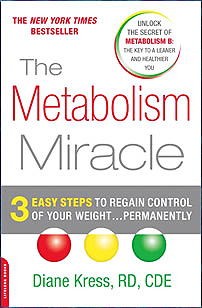August 27, 2012
Living The Metabolism Miracle

By Michael D. Shaw
A couple of weeks ago, we chronicled the story behind Diane Kress’ “Miracle” trilogy. This series of books resulted from Diane’s efforts to explain how at least 40 percent of her patients were not getting the weight loss or blood chemistry results they should have been obtaining—according to the conventional wisdom. In her research as a registered dietitian and certified diabetes educator, two groups emerged, which she calls Metabolism A and Metabolism B.
Metabolism B includes those individuals who have Metabolic Syndrome. These were the people who were not getting the expected results, despite following exactly the same diet as the Met A folks.
Metabolic syndrome is a condition marked by the presence of usually three or more of a group of factors (as high blood pressure, abdominal obesity, high triglyceride levels, low HDL levels, and high fasting levels of blood glucose) that are linked to an increased risk of cardiovascular disease and type 2 diabetes. The condition is also called insulin resistance syndrome and syndrome X.
Metabolism A includes those individuals fortunate enough to not have Metabolic Syndrome.
As Diane explains:
Insulin resistance occurs when the normal amount of insulin secreted by the pancreas is not able to work effectively. When insulin does not “fit” the cell’s receptors appropriately, it cannot work effectively. Eventually, the pancreas cannot keep up with the body’s need for insulin, and excess glucose builds up in the bloodstream. Ironically, many people with insulin resistance have high levels of glucose and high levels of insulin circulating in their blood at the same time.
It has been have known for decades that the only nutrient significantly impacting blood glucose levels is carbohydrate. As such, it stands to reason that a low-carb diet would be indicated to deal with metabolic syndrome, not to mention diabetes. Indeed, there is a growing body of clinical evidence that attests to this, and even the obdurate American Diabetes Association grudgingly admits that low-carb diets are helpful for managing diabetes. Notably, though, the ADA cravenly backs off, rationalizing that low-carb is too difficult for people to “live with long term.”
To quote About.com’s Laura Dolson…
[I]nstead of trying to help people follow the diet that is best for them, this prominent organization admits to recommending a diet that is less healthy for diabetics—a diet that could cause a type 2 diabetic to take more medication, progress to becoming dependent on insulin, or even suffer from any of a number of health problems caused by poor blood glucose control.
In essence, Diane Kress’ approach does provide a method to help people follow the diet that is best for them. To understand how the Metabolism Miracle differs from typical low-carb diets, consider two important points…
Five grams of net carbs (total carbs minus fiber) or less, consumed over a five-hour period, has a negligible effect on blood glucose, even in Type 1 diabetics.
Should approximately five hours pass without eating, the liver will self-feed the body by breaking down glycogen, releasing the equivalent of 45-65 grams of carbs into the bloodstream. Thus, Met B individuals who wait too long to eat might actually see their blood glucose rise, as their pancreas cannot accommodate the liver’s forced rush of glucose. Type 2 diabetics have long called this “liver dump.”
The Metabolism/Diabetes Miracle consists of three steps:
1. Carb detox
2. Carb rehab
3. Carb-balanced maintenance
Step 1 consists of eight weeks of a lower-carb diet, intended to rest and rehab the overworked pancreas. This step includes liberal amounts of neutral foods such as lean protein, heart-healthy fats, and vegetables, with the option of a 5 gram carb choice at all meals.
Step 2 consists of eight-plus weeks of the base foods from Step 1, plus the addition of what Diane calls “gentle carb choices” in the right amount, at the right time. During the first four days of Step 2, your liver will gradually refill with glycogen, and will go back to its self-feeding role. Essential here are the findings from Diane’s research, whereby consuming 11-20 grams of net carbs—approximately every five hours—will prevent liver dump.
Step 3 occurs when you reach your desired weight, and your blood glucose, blood pressure, and other lab readings are normal on as little medication as possible. This step establishes your own personal carbohydrate range, and brings in a greater quantity and variety of carbohydrate foods.
Metformin, the first-line drug for type 2 diabetics, works primarily by preventing liver dump. (The drug also decreases intestinal absorption of glucose, and improves insulin sensitivity by increasing peripheral glucose uptake and utilization.) As we have seen, however, liver dump can also be prevented—naturally—by consuming the proper amount of carbs at the proper time. Since pharmaceutical therapy for hyperglycemia does nothing to rehab the pancreas, many type 2 diabetics on oral meds must eventually resort to insulin injections.
Logic and right reason compel us to embrace Diane Kress’ Metabolism Miracle. Likewise, we must resoundingly condemn the dangerous conventional wisdom regarding appropriate therapies for Metabolic Syndrome.

